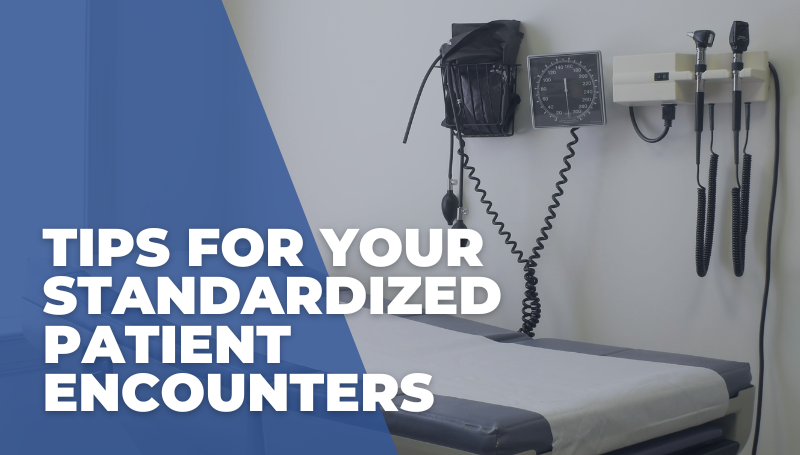
Key points:
- A standardized patient encounter is a simulated patient exam used in medical education to get you more comfortable with patients and assess your clinical skills.
- Standardized patients (SPs) are actors or actresses trained to portray a patient with a particular medical condition or scenario.
- Try to make your SP feel as comfortable as possible. You can ask your SP for their preferred name and pronouns, use appropriate body language (like a smile and friendly tone of voice), give the SP time to speak their concerns, and use your active listening.
- Your encounter will most likely be timed, so practice managing your time effectively to ensure you cover all the necessary elements of the encounter within your allocated time.
- After the encounter, you'll receive feedback from the SP and/or your instructor on how you did and if there are any areas to work on for next time.
Standardized patient encounters are set up during medical school to allow you to practice your clinical skills in a controlled environment as part of your medical training. These encounters can certainly be intimidating, especially if you're not feeling prepared! With the right mindset, you'll crush your first standardized patient encounter and set yourself up for success in your future rotations.
We've got 8 tips for you to prepare for and crush your standardized patient encounter, but first, what exactly is it and what do you do?
What is a standardized patient encounter?
A standardized patient encounter is a simulated patient exam used in medical education to get you more comfortable seeing patients and assess your clinical skills.
In other words, you'll get to test out your doctoring on an actor or actress before the real deal.
What is a standardized patient (SPs)?
Standardized patients (SPs) are trained to portray a patient with a particular medical condition or scenario. These encounters are designed to provide you with an opportunity to practice your exam skills, bedside manner, clinical reasoning, and dx skills in a controlled environment. Standardized patient encounters can be used throughout medical school to teach and assess a variety of skills, from basic communication and history-taking to more advanced clinical skills.
Want to up your DX skills? Test out the Medical Student Study Strong System. Start a free trial now and get the full Musculoskeletal section for 30 days.
An inside look at the Musculoskeletal section in the Medical Student Core
What happens during a standardized patient encounter?
During a standardized patient encounter, you'll typically be given a specific scenario or patient case to work through with the SP. The SP will act out the scenario and respond to your questions as if they were a real patient.
After the encounter, you'll receive feedback from the SP and/or your instructor on how you did and if there are any areas to work on for next time. These encounters can even help you with skills like navigating how to break hard news to a patient or how to recognize warning signs in medication-seeking patients.
8 tips for your standardized patient encounters
1 Practice with a friend or SO ahead of time:
Effective communication is key in any clinical encounter, and standardized patient encounters are no exception! You can practice active listening, empathy, and clear and concise explanations with a friend, family member, or significant other before your encounter. Or, find a group of peers who are also prepping for their standard patient encounters and practice with them. Take turns playing the roles and giving each other feedback afterwards.
2 Practice active listening during the encounter:
When you're in the encounter you might find yourself getting nervous or focusing too much on how you're doing that you're tuning out the SP. Take a breath and focus on the situation. Make sure to listen carefully to the SPs concerns and avoid interrupting them. Use open-ended questions to get more information. And, don’t be afraid to ask for clarification if something is unclear during the encounter. This shows that you are paying attention and actively trying to understand the SPs condition.
3 Make your SP feel comfortable:
As always, make sure to introduce yourself and your role when you enter the room. Try to make them feel comfortable from the very beginning, just like you would want from your doctor at a visit. You can ask your SP for their preferred name and pronouns, use appropriate body language (like a smile and friendly tone of voice), give the SP time to speak their concerns, and use your active listening. At the end of the visit make sure to provide reassurance and ask if there is anything else you can do/anything other concerns they have.
4 Take thorough notes during your encounter:
Taking notes during the encounter will help you to remember important information, especially if you need to review your notes with your evaluator afterwards. Taking good notes also demonstrates to your SP that you're paying attention and taking the encounter seriously.
5 Show empathy to your SP:
Empathy is an essential component of effective communication in a clinical setting. Research has found that patients who feel understood and accepted—empathized with—are more satisfied with their care. Showing empathy towards your SP can help to build trust and rapport, which can lead to more accurate information gathering. Acknowledge their concerns and emotions, and offer reassurance when appropriate. Here's an example to think about: if you were seeing your doctor after a vehicle accident, you might be shaken up, how would you want them to reassure you during your visit?
6 Work on your time management:
Your encounter will most likely be timed, so practice managing your time effectively to ensure you cover all the necessary elements of the encounter within your allocated time. When you're practicing with peers beforehand, make sure you're staying within your allotted time!
7 Reflect on your performance after each encounter:
After each encounter, take some time to reflect on your performance. Think about what you did well, what you could have done better, and how you can improve for your next encounter.
8 Seek feedback afterwards:
Usually when the encounter is over, you'll get feedback from your evaluator and the SP. This will help you to identify areas for improvement and make necessary adjustments for future encounters and your future patients!
Keep in mind that these standardized patient encounters are opportunities for you to learn, grow your knowledge, and practice your clinical skills in a controlled environment! Most who go into medicine are motivated by patient interactions and being able to make a difference in patients lives, this is helping you to get to that point! You got this. Take advantage of these opportunities, and you will be well on your way to success in your future clinical rotations!
Related blogs:


-gif.gif)
